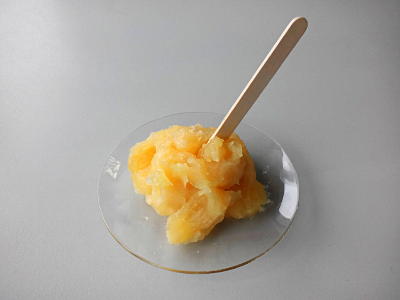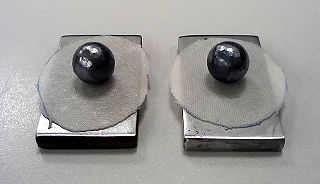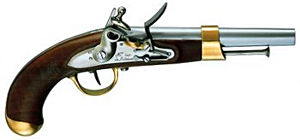
How to Make a Soap-Based Patch Lubricant and Bore Cleaner

|
Oil Soap
After a number of experiments I found that pure oil soap is an excellent (and cheap) raw material for patch lubricants
and bore cleaners for black-powder guns. I further use it as a water-soluble lubricant for nipple threads. Here is how
I make it:
Raw materials:
Vegetable oil (I prefer refined olive oil, high-oleic safflower oil, or frying oil because these have a better oxidation
stability than oils with a higher proportion of polyunsaturated fatty acids.)
Potassium hydroxide (KOH) pellets
Deionized, distilled, or rain water
Equipment:
Lab beaker (borosilicate glass) or stainless-steel pot
Lab stirrer (propeller type, no magnetic stirrer!)
Lab scale
Hotplate
Hot-air oven or baking oven
Lab thermometer
Stainless-steel or plastic spatula
Personal Protective equipment (safety goggles, rubber gloves, lab coat, etc.)
Before you start, keep in mind that potassium hydroxide and its solution are highly corrosive to skin and eyes.
Read the Material Safety Data Sheet first! Use personal protective equipment! Do not use aluminium containers
since they will corrode rapidly. I have run this reaction many times without any problems. Since what other
people are doing is beyond my control, I do not assume responsibility and expressly disclaim liability for
loss, damage, or injuries resulting from unqualified or sloppy working practice.
Vegetable oils are predominantly composed of triglycerides of C16-C18 fatty acids (mostly unsaturated)
and have a saponification value of approx. 185-195 mg KOH / g. This means you need approx. 190 g of pure potassium hydroxide
(or 380 g of the 50% solution) to turn 1 kg of oil into soap. I use only 185 g KOH (370 g of the 50% solution) per 1 kg oil
to avoid an excess of KOH. A soap thus obtained is less irritating to skin and eyes than one with a higher alkalinity.
Procedure:
Dissolve 100 parts (by weight) of potassium hydroxide (KOH) in 100 parts of deionized water with stirring. Caution!
The mixture will get hot while the potassium hydroxide dissolves. Beware of possible boiling retardation! Do not breathe
the fumes released by the hot solution! Observe that commercially available potassium hydroxide (lab grade preferred) may
contain a few percents of water. The KOH content should be noted on the label (85-90 weight-% in most cases). If, for
example, the product contains 90% active material, you have to dissolve 111.2 parts of it in 88.8 parts of water to obtain
a 50% solution. Keep the solution in a closed container (preferably polyethylene) since KOH readily absorbs CO2
from the air and forms potassium carbonate which is not reactive enough for our purpose.
Weigh 500 g of vegetable oil into a beaker, warm it up to approx. 50°C (122 F), and slowly add 185 g of the 50% KOH
solution with vigorous stirring. At first, the mixture has the appearance of an amber-colored emulsion. As the reaction
progresses, the viscosity of the mixture rises gradually. At some point, the product stops flowing and assumes the
consistency of a paste. This might take up to half an hour. Now, remove the stirrer and work the paste with a spatula
for a few minutes. Then, cover the reaction vessel with a lid and put it into a hot-air (baking) oven. Set the
temperature at 80°C (176 F) and let the mixture "mature" for about 6 hours. During this post-reaction,
the paste becomes more transparent. A sample of the final product should be clearly soluble in deionized water (1-2 %
concentration). If you observe oil droplets, the saponification is not complete yet or you have not added enough KOH.
Do not use tap water for this test since the solution will become turbid due to the formation of insoluble calcium and
magnesium soaps. The saponification reaction will not run smoothly in the presence of too much water, for example when
using a more diluted KOH solution.
The reaction product is a mixture of potassium soaps, glycerol, and water. It may further contain small portions of mono
and diglycerides, particularly when a substoichiometric amount of KOH has been used. It is the classic oil soap which
found wide-spread use as a universal household cleaner in the days our (great)grandmothers.
Patch lubricant:
I make my patch lubricant by dissolving 1 part of the soap paste thus obtained in about 4 parts of warm (50°C)
deionized water. This requires continuous stirring and may take a while. The final product is a clear, yellowish liquid.
It is non-corrosive to steel and has excellent lubricating properties. It also makes an excellent bore cleaner concentrate
for black-powder guns.
Bore cleaner:
A solution of approx. 1% of the above soap paste or 5% of the patch lubricant in deionized or rain water is an excellent,
non-corrosive bore cleaner for black-powder guns. Since the paste takes quite a longe time to dissolve, it may be helpful
to make a larger quantity of the patch lubricant and set some aside for making the bore cleaner as needed. The 1% solution
has a limited shelf life (biodegradation of the soap) and should not be stored for more than a few days. Corrosion protection
and shelf life are improved by adding 0.1% sodium benzoate to the bore cleaner. After evaporation of the water portion, the
cleaner leaves a thin protective film on the bore surface.
Soap-free bore cleaners:
Other non-toxic and non-corrosive bore cleaners can simply be made by dissolving a suitable rust inhibitor in deionized water.
A concentration of 0.1% sodium benzoate or monosodium glutamate is sufficient to prevent rust formation. Both substances are
commercially available as food additives. The former is a food preservative while the latter is a popular flavor enhancer.
Monosodium glutamate in water is subject to biodegradation. Therefore, this solution has a limited shelf life and should
be prepared shortly before use. A solution of 0.1% borax (sodium tetraborate decahydrate) in deionized water is also non-corrosive
to steel. Moreover, this cleaning solution can be stored for a long time time.
Corrosion test:
This is a modified version of my earlier corrosion test for patch lubricants. Instead of immersing a steel sample in the
lubricant, I soak a cotton patch in the lubricant, put it on a flat piece of mild steel (degreased with acetone), and weigh
it down with a lead ball (see photo). I further cover the samples with a glass jar in order to prevent a rapid evaporation
of the water portion of the lubricant. This test assembly emulates the conditions in a barrel loaded with patch and ball.
After 24 hours, I remove ball and patch and examine the steel surface for signs of corrosion. A patch lubricant failing this
test (such as saliva, for example) is not fit for use in my opinion.

|
Corrosion Test
Addendum:
There are liquid, ready-to-use "oil soaps" on the market. These are pre-diluted with water and may contain a number of
additives, for example complexing agents (EDTA, phosphates, etc.), to make them usable with hard water (contains calcium and
magnesium salts). My experience with industrially made "oil soaps" is somewhat mixed. One of the products I tested actually
proved to be corrosive to steel, and I suspect it to contain sodium chloride (table salt)*. Furthermore, technical
grade KOH may contain a small amount of sodium chloride. Since sodium chloride can promote corrosion even at low concentrations,
lab grade KOH should be used. Check for yourself. Run a corrosion test before using any product with unknown composition.
* Salt is often used by the industry to increase the viscosity of detergent formulations (shampoos,
household cleaning agents).
Will be continued...

